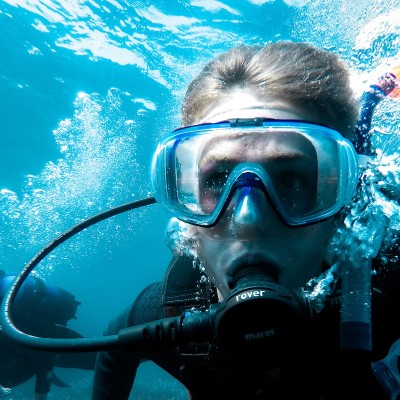Table of Contents

What Is A Regulator?
A scuba diving regulator is arguably the most critical piece of equipment a diver has as it allows humans to breathe underwater. Every diver should have a basic understanding of the parts of their regulator and how this equipment works.
The Parts of a Regulator
The following are the standard parts of a scuba diving regulator.
The First Stage
The first stage of a scuba regulator is the part that attaches to the scuba tank valve. It reduces the high tank pressure (usually around 3000 psi) to an intermediate pressure (usually 120-150 psi). This intermediate pressure is then delivered through hoses to the regulator’s second stage, BCD inflator, SPG, and alternate air source. If diving in cold water, a hose will connect the first stage to a drysuit.
The Second Stage
Also known as the demand value, the second stage is the mouthpiece that delivers air to a diver.
Alternate Air Source AKA Octopus
Typically bright yellow, this second mouthpiece allows divers to share air with another diver in the event of an emergency.
BCD Inflator
The BCD Inflator is connected to the first stage through a low-pressure hose and allows a diver to add air to increase buoyancy as needed.
SPG
The SPG is a device that measures the amount of air remaining in a scuba tank. It is typically attached to the high-pressure port on the first stage regulator and provides the diver with a visual indication of their remaining air supply.
Every diver learns to use their regulator during the open water class properly.
Should Every Diver Own Their Regulator?
It is always best to own your scuba regulator. Divers who own their gear know it better than anyone else. They know how many dives it has been used on, how often it has been serviced, and how to adjust it for their personal preferences. This knowledge can help them avoid problems and dive safely.
However, renting a regulator is a perfectly acceptable option. Many divers rent for years to test different brands and models before investing in their own.
What Factors Should Be Considered When Shopping For A New Regulator?
When shopping for a scuba regulator, there are several factors to consider, including:
- Balanced vs. unbalanced: Balanced regulators maintain a constant breathing resistance at all depths, while unbalanced regulators become more difficult to breathe from as you go deeper. Balanced regulators are generally more expensive, but they are also more comfortable to breathe from, especially on deeper dives.
- DIN vs. yoke: DIN regulators are more popular among technical divers because they are more secure and less likely to leak. Yoke regulators are more common on recreational diving gear.
- Breathing resistance: The breathing resistance of a regulator is how difficult it is to breathe from. Regulators with lower breathing resistance are more comfortable to use, especially on longer dives.
- Hoses and mouthpiece: The hoses and mouthpiece of a regulator should be comfortable and easy to use. However, these can typically be replaced with options that suit a diver’s personal preferences and facial structure.
- Ports: Regulators have different numbers and types of ports for attaching hoses and accessories. Make sure to choose a regulator with enough ports for the gear you plan to use.
- Price: Regulators can range in price from a few hundred dollars to over a thousand dollars. It is important to find a regulator that fits your budget and needs.
- The type of diving you plan to do: If you plan on doing technical diving or diving in cold water, you will need a regulator that is designed for those conditions.
- The availability of service: When you buy a regulator, it is important to choose a model that is serviced locally. This will ensure that you can get your regulator serviced quickly and easily when needed.
